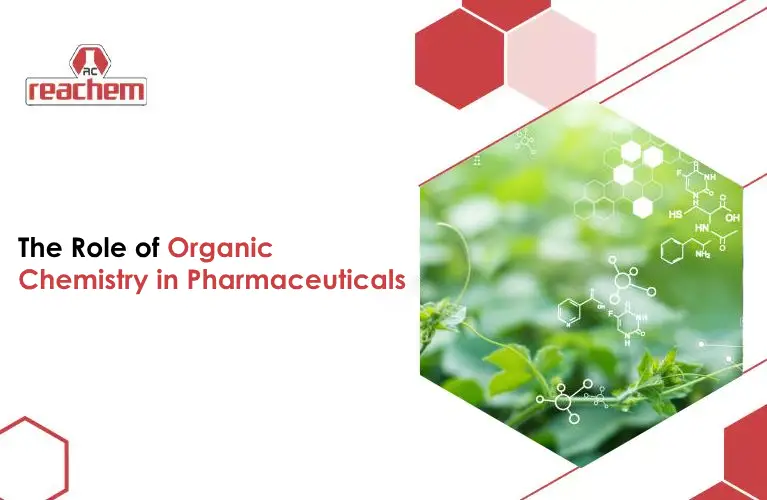wordpress-seo domain was triggered too early. This is usually an indicator for some code in the plugin or theme running too early. Translations should be loaded at the init action or later. Please see Debugging in WordPress for more information. (This message was added in version 6.7.0.) in /var/www/reachemchemicals.com/blog/wp-includes/functions.php on line 6121
Organic chemistry in pharmaceuticals is the intricate science behind the medicines that improve and save lives. It plays a fundamental role in developing, synthesising, and understanding pharmaceutical compounds. This blog will delve into organic chemistry and its applications in the pharmaceutical industry. From drug discovery and design to synthesis and formulation, we’ll uncover how organic chemistry drives innovation and advancement in medicine. So, embark on a journey to unravel the mysteries of organic chemistry in pharmaceuticals.
Organic chemistry involves exploring compounds that incorporate carbon atoms. In pharmaceuticals, organic chemistry focuses on understanding the structure, properties, and reactions of organic molecules that form the basis of drugs. Here’s what you need to know:
Carbon serves as the backbone of organic molecules found in pharmaceuticals. Understanding the versatility of carbon atoms allows chemists to manipulate molecular structures to achieve desired pharmacological properties.
Functional groups are specific arrangements of atoms within organic molecules that impart unique chemical properties. Chemists utilise functional groups to modulate pharmaceutical compounds’ activity, solubility, and stability.
Stereochemistry concerns the spatial organisation of atoms within a molecule. In drug design, stereochemistry plays a crucial role in determining pharmaceutical agents’ biological activity and selectivity.
Organic chemistry encompasses various synthetic techniques, including classical organic reactions, transition metal catalysis, and bioconjugation methods. These techniques enable the synthesis of diverse chemical structures with potential therapeutic applications.
Organic chemistry provides the foundation for drug discovery and design by elucidating the structure-activity relationships of pharmacologically active compounds.
Drug discovery is a complex process. It involves identifying potential drug targets, screening compound libraries, and optimising lead compounds for therapeutic efficacy. Organic chemistry holds a pivotal position in this process. Now, explore further:
Organic chemistry informs the selection of drug targets based on the underlying molecular mechanisms of diseases. By understanding the biological pathways involved in disease progression, researchers can identify potential targets for drug intervention.
High-throughput screening techniques allow researchers to test thousands of compounds for their activity against specific drug targets. Organic chemistry provides the chemical diversity needed to populate compound libraries for screening purposes.
Once promising lead compounds are identified, organic chemistry is employed to optimise their pharmacokinetic and pharmacodynamic properties. This involves structural modifications to enhance potency, selectivity, and metabolic stability while minimising toxicity.
In silico methods, such as molecular docking and quantitative structure-activity relationship (QSAR) analysis, complement experimental approaches in drug discovery. Organic chemistry principles guide computational simulations to predict ligand-receptor interactions and optimise drug candidates.
Organic chemistry drives the iterative process of drug discovery and design, leading to the development of novel therapeutic agents for various medical conditions.
The next step is synthesising them on a large scale for preclinical and clinical evaluation. Organic chemistry methodologies are employed to synthesise pharmaceutical compounds efficiently. Here’s how it’s done:
Organic chemists devise synthetic routes to assemble complex molecules from simple starting materials efficiently. This often involves using strategic bond-forming reactions and protecting group strategies to control reactivity and stereochemistry.
Optimization of synthetic processes is essential to ensure scalability, reproducibility, and cost-effectiveness. Organic chemists optimise reaction conditions, purification techniques, and yield maximisation strategies to streamline the synthesis of pharmaceutical compounds.
There has been a growing emphasis on sustainable and environmentally friendly synthetic methodologies in pharmaceutical manufacturing in recent years. Organic chemistry principles are applied to develop greener synthetic routes that minimise waste, energy consumption, and environmental impact.
Flow chemistry is gaining popularity in pharmaceutical synthesis due to its advantages in reaction control, safety, and scalability. Organic chemistry techniques are adapted to continuous flow reactors, which facilitates the rapid and efficient synthesis of pharmaceutical intermediates and active compounds.
Organic chemistry methodologies enable the efficient synthesis of pharmaceutical compounds. It paves the way for their translation from the laboratory to clinical practice.
In addition to synthesising pharmaceutical compounds, organic chemistry plays a role in their formulation and delivery to patients. Formulation scientists utilise organic chemistry principles to develop dosage forms that ensure optimal drug delivery and patient compliance. Here’s how it’s done:
Organic chemistry guides the selection of excipients and formulation techniques. These techniques enhance the stability, solubility, and bioavailability of pharmaceutical compounds. Formulation scientists employ nanoparticle encapsulation, prodrug design, and controlled-release formulations to optimise drug delivery.
Organic chemistry is instrumental in designing drug delivery systems that target specific tissues or cells while minimising systemic side effects. Nanotechnology-based drug delivery systems, liposomal formulations, and polymer conjugates are innovative approaches driven by organic chemistry principles.
Organic chemistry is crucial in enhancing the bioavailability of poorly soluble drugs. Techniques like particle size reduction, solid dispersion, and lipid-based formulations are employed. These approaches improve drug absorption and therapeutic efficacy.
Organic chemistry contributes to the development of personalised medicine approaches. These approaches tailor drug formulations and dosages to individual patient needs. This includes utilising molecularly targeted therapies and pharmacogenomics-guided treatment strategies. They aim to optimise therapeutic outcomes and minimise adverse effects.
Organic chemistry contributes to the development of innovative drug delivery systems. These systems enhance the efficacy and safety of pharmaceutical therapies.
Organic chemistry is the backbone of pharmaceutical science, driving drug discovery, synthesis, formulation, and delivery. Through a deep understanding of organic molecules and their reactivity, researchers can develop life-saving medicines. These medicines alleviate suffering and improve the quality of life. By unravelling the mysteries of organic chemistry in pharmaceuticals, we pave the way for continued innovation and advancement in medicine.